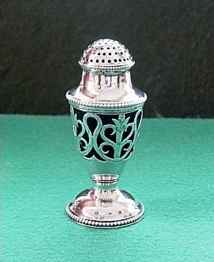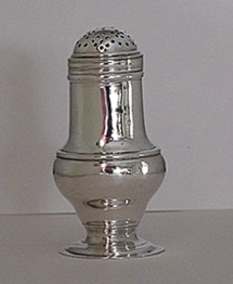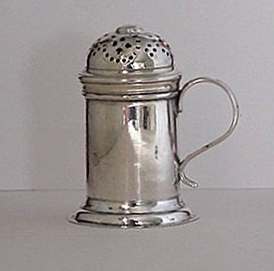(click on photos to enlarge image)
KITCHEN PEPPERS, BUN PEPPERS AND MUFFINEERS
Three mysterious English vessels
The English sugar caster was invented in the reign of
Charles II and by the end of the 17th century it had been joined
by pairs of smaller versions, made to match, whose purpose, it
is believed, was to dispense pepper and cayenne. However by the
early 18th century quite different vessels for dispensing pepper
had come into use and, as they did not take the place of the
caster but were used in parallel with it, there is something of
a mystery surrounding them.
These new vessels originally took two forms, the kitchen pepper
and the bun pepper but by the end of the 18th century these had
been joined by a third; the muffineer (also spelt muffinier).
Although these vessels are casters of a sort, they do not follow
the evolutionary patterns of 18th century casters and their use,
as distinct from casters, has not been definitively determined
by modern historians.
MUFFINEERS
Of the three, muffineers are the most enigmatic and indeed
may not exist at all as something different from a caster.
It is common to see a lot catalogued by an auctioneer as a
muffineer when it would appear to be nothing more nor less than
a caster and it is difficult therefore to determine exactly what
a muffineer is. I once challenged an auctioneer on this having
seen apparently identical items in his catalogues listed in one
as a caster and in the other as a muffineer. His answer was that
it depended on the size but when pressed on this he was unable
to specify a size for either and I was left with the impression
that it all depended on how he felt on the day!
Charles Oman, in his description of casters makes the following
statement: "Large casters are frequently referred to as
dredgers and small ones muffineers. The latter term appears to
be considerably younger than most of the objects to which it is
applied"(note 1).
There is no mention of the muffineer in the Miller's Dictionary
of Antiques, neither does it appear in the pages of the English
Universities Press Dictionary of Antiques.
The following entry does appear, however, in an old copy of
Chambers Twentieth Century Dictionary: "a dish for keeping
muffins hot: a metal cruet for sprinkling salt or sugar on
muffins".
I have come across the former in connection with the early 19th
Century habit of eating muffins. It was a flat dish with a domed
cover made of either porcelain or silver and was designed to
keep muffins warm at table.
The definition given in An Illustrated Dictionary of Silverware
by Harold Newman suggests "A type of small caster.....domed
cover pierced with small circular holes......the lower part
sometimes has pierced decoration and is provided with a blue
glass liner" (note 2).
This latter is referred to on page 131 of Three Centuries of
English Domestic Silver 1500 -1820 by Bernard and Therle Hughes
(note 3). I reproduce
the reference here in its entirety on the understanding that it
may have some relevance.
"Toward the end of the eighteenth century when it became
customary to sprinkle cinnamon on hot buttered muffins, small
casters were used, of spice dredger size but without handles.
These were known as muffineers. The majority were vase-shaped,
never more than four inches high, with low-domed sprinklers
drilled with fine circular holes. The bodies of eighteenth
century examples might be embossed or engraved: later they were
seldom ornamented. Another series of muffineers had their bodies
fret-cut in the neo-classic style and contained liners of blue
glass. These usually had narrow bands of strengthening moulding
encircling their bodies a little below the middle, and plain
moulded bases". Although the spice dredger is mentioned in
this reference I have not come across one of this period and
feel it likely that if spices were used at table then casters
would have been made to accommodate them designed to match the
casters of the time and this patently did not happen. The
likelihood is, in fact, that the reference is to kitchen peppers.
Sir Charles Jackson records a muffineer as having on it the
maker's mark of Richard Gurney and Thomas Cook which they
registered in 1734 but as I can find no other references to
muffineers at this early date my opinion is that Jackson’s
terminology is ambiguous and that the vessel in question was
probably a caster.
There is a reference in Parson Woodforde’s diary for the year
1788 which reads "Mr. Du Quesne made me a present of a small
silver muffineer this afternoon"
(note 4) and this,
because of the use of the word 'small', suggests something of
the 'dredger' sort mentioned above.
It seems that at the end of the 18th century and
throughout the 19th muffins were eaten with cinnamon,
salt or sugar sprinkled on them and for this a small
vessel was used of a size which at the beginning of
the 18th century would have been called a kitchen
pepper and in the 19th century would have been known
as a pepperette. Marking is under the foot and the
tops are usually unmarked. These small vessels are
often called muffineers and have been given no other
nomenclature.
I have seen an advertisement by Mappin & Webb said
to be dated 1894 which reads: Two Sterling Silver
Muffineers, Fluted, in rich Morocco Case, lined Silk
and Velvet, complete, £2-5s.
The picture showed a pair of "casters"!
|
 |
|
Muffineer ( possibly ) of 1779
by Charles Aldridge & Henry Green
|
BUN PEPPERS
Bun peppers on the other hand have a much more solid
historical background although they, too present something of a
mystery.
They were produced during the reigns of Geo I
and Geo II, are usually of baluster shape and,
although they vary in size, can be virtually the
same size as a caster.
The obvious difference in appearance between the bun
pepper and the caster is that instead of a high
domed perforated top surmounted by a finial these
vessels have low domed tops, usually pierced with
simple holes and have no finial, hence the term "bun"
pepper. On close examination it will be found that
the top, instead of being secured by means of a push
fit sleeve which slides into the body of the vessel,
as with casters of the period, fits over the body
but again as a push fit.
Marking is underneath and the tops are often
unmarked. When they are marked just the sterling
lion is used and is punched actually inside the top
so that it is usually quite difficult to read. It
would appear that these items were sent to 'Hall'
for marking before the holes were drilled in their
tops and thus the marks were drilled through. It
should be noted that tops of bun peppers should
always be thoroughly examined in order to 'find' the
mark as a marked top makes the item worth more than
an unmarked one.
|
 |
|
Bun Pepper of 1754 by Jabez Daniell
|
The mystery is; what were bun peppers for? They do not match
contemporary casters and yet they can have a similar capacity.
They must have been used at table but were they, perhaps, for
less formal occasions?
All that can be said of them is that they appear to have been
made singly and are usually undecorated except, on occasion, for
armorials.
KITCHEN PEPPERS
The kitchen pepper also presents a puzzle with regard to
it’s place in the range of domestic plate.
It is difficult to know why a gentleman would
provide a vessel in sterling, or even Britannia,
silver for kitchen use especially as they are not of
a size which would be of much use in preparing large
quantities of food. Pewter would be much more
suitable for this purpose!
Like the muffineers described by the Hughes' in
their book mentioned above, they are not more than
four inches high and usually much nearer three so
that their size would suggest that they were for
table use and yet we already have the anomaly of the
bun pepper in this connection. The Hughes' suggest
that they may have been spice dredgers but I feel
that if spices were used at table, other than the
peppers mentioned in connection with casters, then
additional casters would have been produced to match
existing ones.
Were they, perhaps, intended for use by the senior
staff in the "big house" or possibly only at the
breakfast table?
|
 |
|
Kitchen Pepper of 1731 by James Stone
|
These rather charming little vessels were produced, like bun
peppers, during the first half of the 18th century and like bun
peppers they are usually undecorated. They are simple in
construction being nothing more than a cylinder standing on a
raised foot with a simple "S" or loop scroll handle soldered to one
side. The perforations in the push fit top are often just
drilled holes in a low dome although some, as in the one
illustrated here, were also given a little of the more ornate
piercing of the sort found in long tea strainer (mote) spoons of
the period. This top is almost always without embellishment
although examples with finials are not unknown and the slightly
more ornately pierced ones may have small bun-like additions at
their highest points. Marks will be found on the body or under
the base depending on date (Queen Anne=body and Geos I & II=base).
As with bun peppers tops fit over the body and are often
unmarked.
Although the term "kitchen pepper" suggests a humble object they
are not as plentiful as might be expected and they are,
therefore, relatively expensive.
To sum up; kitchen and bun peppers were produced during the
first half of the 18th Century, though later examples can be found,
and are very much less formal than casters of the period.
It is difficult to know exactly how
they fitted into the range of household plate and indeed exactly
how they were used. Muffineers apparently did not appear until
the end of the 18th century and may, in fact, have been casters
in all but name. It is a fact, however, that the small vessels
with the blue glass liners which appeared at the end of the
century do pre-date pepperettes which did not come on the scene
until the 19th century. These may therefore be true muffineers.
They were used to sprinkle salt, sugar or cinnamon on muffins.
David McKinley
- 2011 -
David McKinley devotes much of his time to researching
the history of silversmithing in England with particular
reference to hallmarking at the London office. He writes
for both The Silver Spoon Club of Great Britain and The
Silver Society.
|
|
 ASSOCIATION OF SMALL COLLECTORS OF ANTIQUE SILVER
ASSOCIATION OF SMALL COLLECTORS OF ANTIQUE SILVER ASSOCIATION OF SMALL COLLECTORS OF ANTIQUE SILVER
ASSOCIATION OF SMALL COLLECTORS OF ANTIQUE SILVER